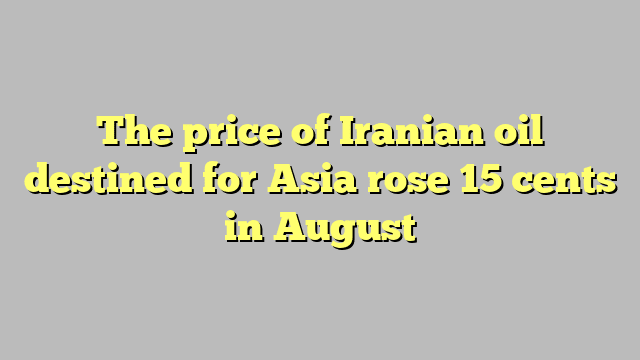The price of Iranian oil destined for Asia is scheduled to rise, during next August, by about 15 cents compared to the current month of July, at a value that is 5 cents lower than the prices of Saudi Aramco shipments during the next month.
The National Iranian Oil Company announced the official selling prices for August shipments to its customers in the Asian, Middle Eastern and European markets, according to a price document seen by the specialized energy platform.
The company raised the price of Iranian light oil in July by about $0.15, at $3.15 above the Amman/Dubai average, compared to July shipments, which were only $3.
The price of Iranian heavy crude destined for Asia rose about 5 cents to $1.10 above the Dubai/Oman average over the next month, compared to July shipments, which were $1.05 above the Dubai average.
And the Iranian Oil Company decided to increase the prices of Forouzan crude shipments to Asia during August by about 10 cents, to record $ 1.05 above the average Dubai / Oman crude, compared to $ 0.95 in July, according to a pricing document seen by the specialized energy platform.
Iranian oil price in august
The National Oil Company in Tehran has informed its clients in Europe, the Middle East and Africa of the increase in Iranian oil prices next August.
Iranian light crude shipments are scheduled to record about $2.10, $1.60, and $2.10 above the average of Brent crude for the three markets, respectively, with an increase of $0.79, 1, and $0.75, compared to $1.35, 0.6, and $1.35 above the average of Brent crude for the three markets, respectively. consecutively in July.

Tehran decided to raise the selling price of heavy crude oil by about 80 cents to European markets at $0.60 above average Brent crude, one dollar to the Middle East at $0.10 below average Brent, and 80 cents to Africa at $0.60 above average Brent crude, compared to prices. July shipments to European markets were $0.20 below average Brent, the Middle East at $1.10 below average Brent, and Africa at $0.20 below average Brent.
And the Iranian Oil Company announced an increase in the prices of Forouzan crude shipments during August, about $0.9 to Europe and Africa, to $0.50 above average Brent crude, compared to $0.30 below Brent crude in July.
Saudi Aramco prices
Early this month, Saudi Aramco announced the official prices for selling shipments of Arab Light crude to its customers in Asia, Europe and the United States, during the coming month of August (2023).
The company raised Saudi Arabia’s official selling prices for Arab Light crude to Asia by 20 US cents to $3.2 per barrel, above the Oman/Dubai average, according to the pricing document seen by the specialized energy platform.
The decisions to raise prices by Riyadh, Tehran and the countries of the Middle East come after expectations of a shortage of supplies in the markets during the next month, after Saudi Arabia extended the additional production cut by one million barrels per day next August, subject to extension, to face macroeconomic headwinds that caused a recession in the markets. .
It is scheduled that the reduction of one million barrels per day will be added to the voluntary reduction previously announced by Saudi Arabia in April 2023, and which extends until the end of December 2024.
According to the Kingdom’s pledge to voluntary reduction, Saudi Arabia’s oil production in August 2023 is scheduled to reach approximately 9 million barrels per day, according to data from the specialized energy platform.
The official selling prices for Saudi crude are usually released on the fifth of every month, and set the trend for Iranian, Kuwaiti and Iraqi prices. This affects the 9 million barrels per day of crude destined for Asia.

Leave a Reply